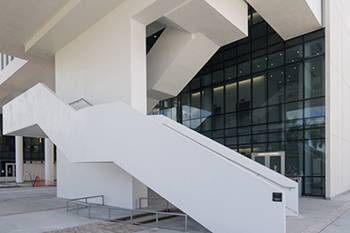FIU’s Stempel Complex Designed for Natural Disaster Research
 MIAMI — Florida International University in Miami recently debuted its new $31.7 million Stempel Complex, which was designed for high-tech research programs that will study the effect of extreme natural events on people, society and economics.
MIAMI — Florida International University in Miami recently debuted its new $31.7 million Stempel Complex, which was designed for high-tech research programs that will study the effect of extreme natural events on people, society and economics.
The facility’s design, created by the Miami office of Perkins + Will, incorporates new technology trends that allow for flexibility, adaptability, collaboration and executing a multidisciplinary approach, said Pat Bosch, design director at the architecture firm’s Miami office. As such, there are also several green building elements involved in the design, and the facility is currently tracking LEED Gold certification. Skanska USA, with offices in Ft. Lauderdale, Fla., served as the construction manager on the project.
“The main goal of the Stempel Complex project was to house a series of programs that are at the core of Florida International University’s overarching mission: to conduct innovative research that has the power to transform communities,” Bosch said.
The 119,000-square-foot complex houses various academic and research programs that combine to form the Extreme Event Institute. The design incorporates flexible research and teaching space for research programs in the Robert Stempel College of Public Health and Social Work, Behavioral Health Research and Clinical Labs, Earth and Environment, and the International Hurricane Research Center. The institute will research and provide data to the U.S. government, National Oceanic and Atmospheric Administration and other international meteorological agencies and institutes.
The building design itself was inspired by various elements and studies of natural events such as hurricanes, earthquakes and tsunamis. The complex is designed around an oval-shaped central courtyard, which provides daylighting to all the interior spaces and allows for flexibility and internal reconfiguration as well as promotes self-shading and enhances circulation.
The central courtyard orients itself to the quad with increased connectivity due to the raised research labs two stories above. These floors are offset slightly to provide self-shading solar protection along the south and west facades. The east exposure continues the alternating glass and precast concrete rhythm, transforming into large solar shading fins.
“With its multitude of systems and environmentally conscious design, the
Stempel Complex is a high-performing, smart building that engages metaphors of nature, gateways, innovation and discovery,” Bosch said. “It frames nature via courtyards and gateways and represents it by virtue of daylighting, transparency and fluid architectural shapes. The building also features chilled beam technology for cooling, daylighting and harvesting.”
The main challenge was creating the proper flexible environment in which several colleges would share space for the first time at Florida International University, Bosch said. However, the university’s commitment to collaboration and the vision behind the project really helped conceptualize the building.
“It was like ‘constructing’ the dreams and goals of the faculty and students who
utilize [the facility] each day,” she added.
This was not the first project that Perkins + Will completed for Florida International University. The design firm also designed the university’s school of International and Public Affairs as well as the Science Classroom Complex — both of which were designed to achieve LEED Gold certification.
